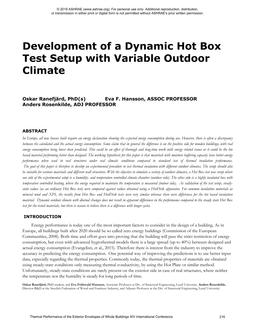Description
In Europe, all new houses built require an energy declaration showing the expected energy consumption during use. However, there is often a discrepancy between the calculated and the actual energy consumption. Some claim that in general the difference is on the positive side for wooden buildings, with real energy consumption being lower than predicted. This could be an effect of thorough and long-time work with energy related issues or it could be the bio based material performing better than designed. The working hypothesis for this paper is that materials with moisture buffering capacity have better energy performance when used in real structures under real climatic conditions compared to standard test of thermal insulation performance. The goal of this paper is therefore to develop an experimental procedure to test thermal insulation with different outdoor climates. The setup should also be suitable for various materials and different wall structures. With the objective to simulate a variety of outdoor climates, a Hot Box test was setup where one side of the experimental setup is a humidity- and temperature controlled climate chamber (outdoor side). The other side is a highly insulated box with temperature controlled heating, where the energy required to maintain the temperature is measured (indoor side). As validation of the test setup, steady-state values (as an ordinary Hot Box test) were compared against values obtained using a HotDisk apparatus. For common insulation materials as mineral wool and XPS, the results from Hot Box and HotDisk tests were very similar whereas there were differences for the bio based insulation material. Dynamic outdoor climate with diurnal changes does not result in apparent differences in the performance compared to the steady state Hot Box test for the tested materials, but there is reason to believe there is a difference with longer cycles.
Citation: Thermal Buildings XIV 2019
Product Details
- Published:
- 2019
- Number of Pages:
- 9
- Units of Measure:
- Dual
- File Size:
- 1 file , 940 KB
- Product Code(s):
- D-Bldgs19-023




